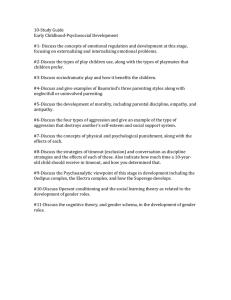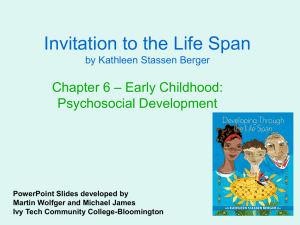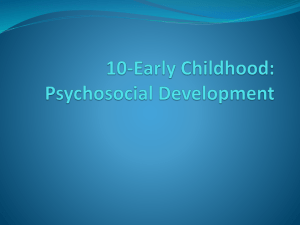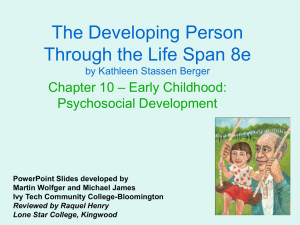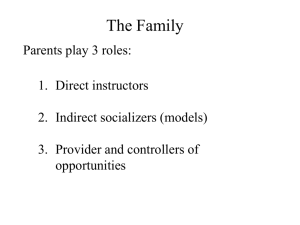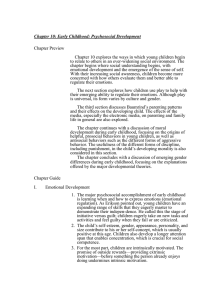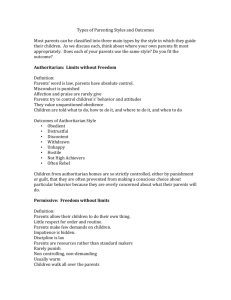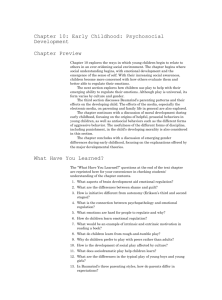Invitation to the Life Span by Kathleen Stassen Berger
advertisement
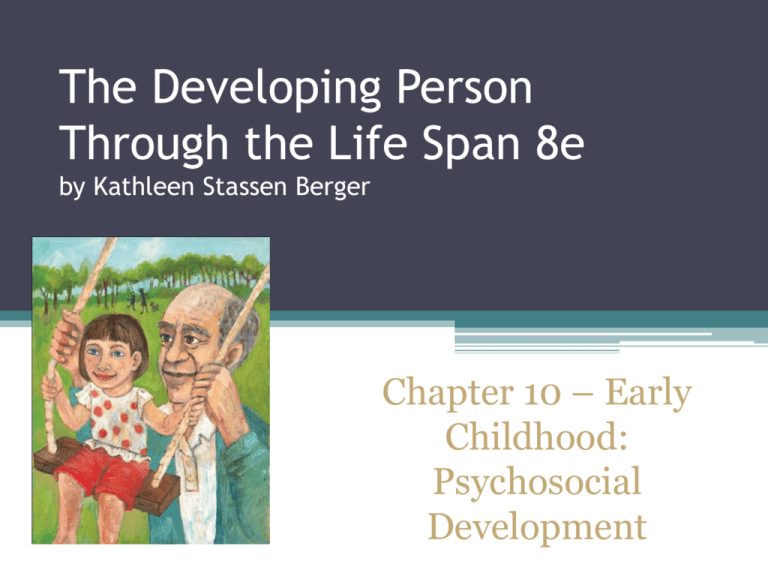
The Developing Person Through the Life Span 8e by Kathleen Stassen Berger Chapter 10 – Early Childhood: Psychosocial Development Erickson’s Theory • Initiative versus guilt • Erikson’s third psychosocial crisis, in which children undertake new skills and activities and feel guilty when they do not succeed at them. Emotional Development • Increases in: ▫ Emotional Understanding ▫ Emotional Regulation • Development of ▫ Self-concept Seeking Emotional Balance • Lack of emotional regulation may be an early sign of psychopathology (disorder of the mind) • Externalizing problems ▫ expressing powerful feelings through uncontrolled physical or verbal outbursts, as by lashing out at other people or breaking things • Internalizing problems ▫ turning one’s emotional distress inward, as by feeling excessively guilty, ashamed, or worthless The Brains of Boys and Girls • Neurological and hormonal effects: ▫ Boys tend to be aggressive (externalizing) ▫ Girls tend to be anxious (internalizing) • Psychopathology is not typical! ▫ Children of both sexes usually learn to regulate their emotions as their brains mature and their parents nurture them Play • Play is the most productive and enjoyable activity that children undertake • Play is universal and timeless Play Form of play changes with age and culture • Increasingly complex social play is due to brain maturation coupled with many hours of social play • Children must learn how to make, and keep, friends • Young children play best with peers • Toddlers are not yet good playmates Playmates Peers • People of about the same age and social status • Provide practice in emotional regulation, empathy, and social understanding • Children usually prefer to play with each other rather than with their parents Impact of Environment Physical setting of a culture shapes play • Some communities provide many toys and close supervision • Others leave children to play on their own with whatever they find Parental influences shape children’s peer relationships • Direct versus indirect influences Differences in Play Types of Play 1.Solitary play: A child plays alone, unaware of any other children playing nearby. 2.Onlooker play: A child watches other children play. 3.Parallel play: Children play with similar toys in similar ways, but not together. 4.Associative play: Children interact, observing each other and sharing material, but their play is not yet mutual and reciprocal. 5.Cooperative play: Children play together, creating and elaborating a joint activity or taking turns. Active Play • Rough-and-tumble play: Play that mimics aggression through wrestling, chasing, or hitting, but in which there is no intent to harm. ▫ Expressions and gestures (e.g. play face) signifying that the child is "just pretending” ▫ Particularly common among young males ▫ Ample space, distant adults, and presence of friends increase likelihood ▫ Advances children’s social understanding but increases likelihood of injury Active Play Drama and Pretending • Sociodramatic play: Pretend play in which children act out various roles and themes in stories that they create. • Sociodramatic play enables children to: ▫ Explore and rehearse social roles ▫ Test their ability to explain and to convince playmates of their ideas ▫ Practice regulating their emotions by pretending to be afraid, angry, brave, and so on ▫ Develop a self-concept in a nonthreatening context Drama and Pretending Parenting Styles Parents differ on four important dimensions: 1.Expressions of warmth: From very affectionate to cold and critical 2.Strategies for discipline: Parents vary in whether and how they explain, criticize, persuade, ignore, and punish. 3.Communication: Some parents listen patiently to their children; others demand silence. 4.Expectations for maturity: Parents vary in the standards they set for their children regarding responsibility and self-control. Child Rearing Styles • Authoritarian parenting • Permissive parenting • Authoritative parenting • Neglectful/uninvolved parenting Children of authoritarian parents tend to • become conscientious, obedient, and quiet but not especially happy • feel guilty or depressed and blame themselves when things don’t go well • rebel as adolescents and leave home before age 20 Children of permissive parents tend to • be unhappy and lack self-control, especially in peer relationships • suffer from inadequate emotional regulation • be immature and lack friendships (main reason for their unhappiness) • continue to live at home, still dependent, in early adulthood Children of authoritative parents tend to • be successful, articulate, happy with themselves, and generous with others • be well-liked by teachers and peers, especially in societies in which individual initiative is valued Children of uninvolved parents tend to • be immature, sad, lonely and at risk of abuse • may have social and cognitive problems Problems with Baumrind’s Parenting Styles • Her original sample had little economic, ethnic, or cultural diversity. • She focused more on attitudes than daily interactions. • Some authoritarian parents are very loving toward their children. • Some permissive parents guide their children intensely, but with words, not rules. • She overlooked the child’s contribution to the parent-child relationship. Children, Parents, and the New Media Children, Parents and the New Media • Children who watch televised violence become more violent themselves. • Racial and gender stereotypes are still evident in children’s programs. • Educational television may have positive effects. • Experts recommend that parents limit their young children’s television viewing and spend more time talking and playing with them. Moral Development • Empathy: The ability to understand the emotions and concerns of another person, especially when they differ from one’s own. • Antipathy: Feelings of dislike or even hatred for another person. Moral Development • Prosocial behavior: Actions that are helpful and kind but that are of no obvious benefit to the person doing them. ▫ Increases from age 3 to 6 • Antisocial behavior: Actions that are deliberately hurtful or destructive to another person. ▫ Declines beginning at age 2 Moral Development 1. Instrumental aggression: Hurtful behavior intended to get something that another person has and to keep it. 2. Reactive aggression: An impulsive retaliation for another person’s intentional or accidental action, verbal or physical. 3. Relational aggression: Nonphysical acts, such as insults or social rejection, aimed at harming the social connection between the victim and other people. 4. Bullying aggression: Unprovoked, repeated physical or verbal attack, especially on victims who are unlikely to defend themselves. Physical Punishment • Some researchers believe that physical punishment is harmless; some don’t. • Physical punishment increases obedience temporarily, but increases the possibility of later aggression. • Many children who are spanked do not become violent adults; other factors (e.g. poverty, temperament) are stronger influences. Parental Discipline • Psychological control: involves threatening to withdraw love and support and that relies on a child’s feelings of guilt and gratitude to the parents. • Time-out: involves separating a child from other people and activities for a specified time. Becoming Boys and Girls • Age 2: Children know whether they are boys or girls and apply gender labels consistently • Age 4: Children are convinced that certain toys (such as dolls or trucks) are appropriate for one gender but not the other Sex and Gender • Sex differences: Biological differences between males and females, in organs, hormones, and body shape. • Gender differences: Differences in the roles and behaviors that are prescribed by a culture for males and females. ▫ ▫ ▫ ▫ Initial confusion about gender and sex Age 5: Increased awareness of sex and gender differences Age 8: Belief that their biological sex is a permanent trait Increase of awareness of sex differences, preferences for same-sex playmates and stereotypical gender activities from age 2 to age 8 Theories of Sex Role Development Psychoanalytic Theory • Phallic stage: Freud’s third stage of development, when the penis becomes the focus of concern and pleasure. • Oedipus complex: The unconscious desire of young boys to replace their fathers and win their mothers’ exclusive love. • Superego: The judgmental part of the personality that internalizes the moral standards of the parents. Psychoanalytic Theory • Electra complex: The unconscious desire of girls to replace their mothers and win their fathers’ exclusive love. • Identification: An attempt to defend one’s self-concept by taking on the behaviors and attitudes of someone else. Theories of Sex Role Development Behaviorism • Gender differences are the product of ongoing reinforcement and punishment ▫ "Gender-appropriate" is rewarded more frequently than "gender-inappropriate" behavior • Social learning theory: Children notice the ways men and women behave and internalize the standards they observe Cognitive Theory Gender schema • A child’s cognitive concept or general belief about sex differences, which is based on his or her observations and experiences. • Young children categorize themselves and everyone else as either male or female, and then they think and behave accordingly.
